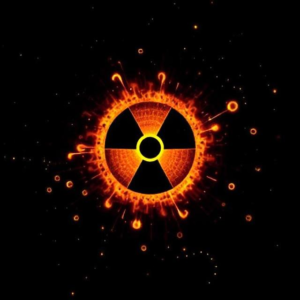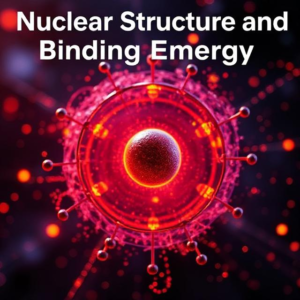Nuclear physics deals with the behavior and interactions of atomic nuclei, which are made up of protons and neutrons. It helps us understand the power behind the sun, nuclear energy, and even the forces inside atoms.

1. Nuclear Reactions
Nuclear reactions happen when atomic nuclei change, often involving the splitting or merging of these nuclei. These reactions can release or absorb a lot of energy.
Simple Example:
Think of it like a big puzzle. If you break a big piece of the puzzle into smaller pieces (fission) or put small pieces together to make a bigger one (fusion), a lot of energy can be released during the process.
2. Fission and Fusion
Fission and fusion are the two main types of nuclear reactions, and they are very different from each other:
- Fission is when a heavy atomic nucleus (like uranium or plutonium) splits into two smaller nuclei, releasing a lot of energy. This is what happens in nuclear power plants and atomic bombs.How it works: A neutron hits the nucleus of a heavy atom, causing it to split. When the nucleus splits, it releases more neutrons and energy in the form of heat. This heat can be used to generate electricity.
Example: The splitting of Uranium-235 or Plutonium-239 in a nuclear reactor.
- Fusion is when two light atomic nuclei (like hydrogen) combine to form a heavier nucleus, releasing energy in the process. Fusion is what powers the Sun and hydrogen bombs.How it works: In the core of the Sun, hydrogen nuclei (protons) collide and fuse to form helium, releasing a huge amount of energy in the process.
Example: The fusion of hydrogen atoms to create helium, releasing energy.
3. Radioactive Decay (Alpha, Beta, Gamma)
Radioactive decay is the process by which unstable atomic nuclei release energy in the form of radiation to become more stable.
There are three main types of radioactive decay:
- Alpha Decay: In alpha decay, the nucleus loses two protons and two neutrons, creating an alpha particle (which is just a helium nucleus). This type of decay happens in heavy elements like Uranium.Example: Uranium-238 decays into Thorium-234 by emitting an alpha particle.
- Beta Decay: In beta decay, a neutron in an unstable nucleus turns into a proton and an electron (called a beta particle). The electron is ejected from the nucleus. This increases the number of protons in the nucleus, turning it into a different element.Example: Carbon-14 decays into Nitrogen-14 by emitting a beta particle.
- Gamma Decay: In gamma decay, the nucleus releases energy in the form of high-energy electromagnetic radiation (gamma rays). This type of decay doesn’t change the number of protons or neutrons, but it helps the nucleus release excess energy.Example: After alpha or beta decay, a nucleus may release gamma radiation to stabilize.
4. Chain Reactions
A chain reaction is a process where the products of a reaction cause more reactions to occur. In nuclear fission, a chain reaction happens when the neutrons released by one fission event go on to hit other nuclei, causing more fission events, and so on.
Simple Example:
- Imagine you light a row of firecrackers. When one firecracker explodes, it causes the next one to explode, and so on. This is like a chain reaction in a nuclear reactor, where one fission event leads to many more.
In a nuclear reactor, the chain reaction is carefully controlled to produce steady energy. In a nuclear bomb, the chain reaction is uncontrolled and happens extremely fast, releasing a massive amount of energy.
5. Nuclear Binding Energy (In Detail)
Nuclear binding energy is the energy that holds the protons and neutrons together inside an atomic nucleus. Without this energy, the nucleus would fall apart.
How it works:
- The protons and neutrons are held together by a force called the strong nuclear force, which is incredibly powerful but only works over very short distances.
- The binding energy is the energy you’d need to break apart a nucleus into its individual protons and neutrons.
- More binding energy means a more stable nucleus. For example, the nucleus of iron has one of the highest binding energies, meaning it’s very stable. This is one reason why fusion (combining lighter nuclei) and fission (splitting heavier nuclei) both release energy. When a heavy nucleus (like uranium) splits, it becomes more stable (with a higher binding energy), releasing energy in the process.
Example:
- Fission: When uranium-235 splits into two smaller nuclei, the total binding energy of the resulting nuclei is higher than the original nucleus. The difference in binding energy is released as energy.
- Fusion: When hydrogen nuclei fuse to form helium, the binding energy of helium is higher, and the difference is released as energy.
Summary:
- Fission: Splitting heavy nuclei (like uranium) to release energy.
- Fusion: Combining light nuclei (like hydrogen) to release energy (the process that powers the Sun).
- Radioactive Decay: Unstable nuclei releasing energy (alpha, beta, gamma radiation).
- Chain Reactions: A series of reactions where each step causes more reactions (important in both nuclear reactors and bombs).
- Binding Energy: The energy that holds the nucleus together; more binding energy = more stability.
In essence, nuclear physics helps explain how energy is produced in stars, how we can harness nuclear energy here on Earth, and how radioactive materials change over time. It’s the science behind some of the most powerful forces in nature











